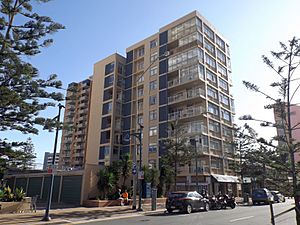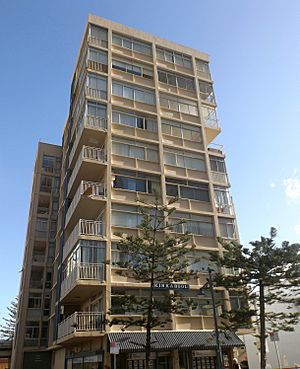Kinkabool facts for kids
Quick facts for kids Kinkabool |
|
|---|---|

Building in 2015
|
|
| Location | 32-34 Hanlan Street, Surfers Paradise, Queensland, Australia |
| Design period | 1940s - 1960s (post-World War II) |
| Built | 1959-1960 |
| Architect | John M. Morton of Lund Hutton Newell Black & Paulsen |
| Architectural style(s) | Modernism |
| Official name: Kinkabool | |
| Type | state heritage (built) |
| Designated | 5 February 2009 |
| Reference no. | 601477 |
| Significant period | 1959-1970 |
| Significant components | shop/s, car park, foyer - entrance, elevator, basement / sub-floor, views from, residential accommodation - home unit/s, views to |
| Builders | J D Booker Constructions (Gold Coast) Pty Ltd |
| Lua error in Module:Location_map at line 420: attempt to index field 'wikibase' (a nil value). | |
Kinkabool is a special apartment building in Surfers Paradise, Australia. It is listed as a heritage site because it was the very first high-rise building on the Gold Coast. Kinkabool was designed by architect John M. Morton and built between 1959 and 1960. It helped start the famous skyline of tall buildings that the Gold Coast is known for today.
Contents
The Story of Kinkabool
Before the 1950s, Surfers Paradise was just a small beach town. But in the 1950s, it grew into a famous holiday spot. This change began with the building of Kinkabool.
How Surfers Paradise Grew
The area south of Brisbane, now called the Gold Coast, has always been popular for beach holidays. In the 1800s, people built holiday homes there. Getting to the beach became easier with steamboats and later, a train line.
The land where Kinkabool stands was first owned by James Beattie in 1869. Later, Johann Meyer bought it and started a ferry across the Nerang River. He also opened the first two hotels in the area. He created a road, now Cavill Avenue, which gave people access to the ocean beach.
In the 1920s and 1930s, more people owned cars. New roads and a bridge made it even easier to visit the coast. In 1933, the area was officially renamed Surfers Paradise. This name showed a new interest in surf beaches, like those in America.
After World War II
After World War II ended in 1945, many soldiers who had visited the Gold Coast during the war returned. They loved the beaches and the weather. This led to a huge building boom.
The term "Gold Coast" was first used to describe the area's new wealth. It became the official name of the city in 1958. Kinkabool was built during this exciting time. Old holiday shacks were replaced by taller buildings, starting with Kinkabool.
New Holiday Styles
In the 1950s, people wanted different kinds of holidays. They had more free time and cars. They also liked the American style of resorts. This led to new types of places to stay, like motels and serviced apartments.
These new apartments had modern things like fridges and washing machines. They were designed for people who wanted to eat out often. Many of these early low-rise buildings have since been taken down.
Kinkabool: The First High-Rise
Kinkabool was the first tall apartment building on the Gold Coast. It was ten storeys high and was called a "giant" by local newspapers. Many other tall buildings were planned, but Kinkabool was the first one actually built.
The idea for Kinkabool came from Stanley Korman, a businessman from Victoria. He had a big vision for the Gold Coast. He wanted it to be a modern holiday resort, like those in Hawaii and Florida. Korman even imagined people flying from other cities to their Gold Coast apartment for the weekend.
Kinkabool was built in a busy part of Surfers Paradise, close to popular restaurants and the beach. Its original name was Poinciana Place. The architects first planned it to be much shorter, but soon decided to make it nine storeys, and then ten. The name Kinkabool is said to come from an Aboriginal word meaning "laughing water."
Building Kinkabool
Construction started in 1959 and finished in 1960. The building cost a lot of money for the time. It had shops on the ground floor and apartments above. The top floor had two special "penthouse" units.
Kinkabool was built using strong materials like reinforced concrete. Its design was simple and modern, with straight lines and flat roofs. This style was popular in the 1950s. The architect, John M. Morton, was from England and brought new ideas to Australia.
Inside, the apartments were considered "luxurious." They had modern kitchens with stainless steel sinks and built-in cupboards. The bathrooms were bright and colourful.
Owning an Apartment
Back then, you couldn't buy an apartment in a high-rise in the same way you do today. Instead, you bought shares in the company that owned the building. This gave you the right to use an apartment. This system was called "company title." Kinkabool was later changed to "strata title" in 1999, which is how most apartments are owned today.
Kinkabool was advertised as a great place for holidays or as an investment. People from New Zealand even rented units for several months. A building manager helped owners and guests with things like cleaning and providing TVs.
Kinkabool's Legacy
Kinkabool was the tallest building on the coast for a while. It appeared in many photos and postcards from the 1960s. After Kinkabool, many other high-rise buildings followed, changing the Gold Coast skyline forever.
The Gold Coast became famous for its tall buildings and beautiful beaches. Kinkabool helped start this trend. Many older, smaller buildings from the 1950s have been torn down, but Kinkabool remains as an important part of the Gold Coast's history.
What Kinkabool Looks Like
Kinkabool is a ten-storey apartment building in the middle of Surfers Paradise. It's just a short walk from the ocean beach. On the ground floor, there are two shop spaces. The apartments above have mostly kept their original design. The two penthouse units on the top floor have been joined together.
The building is made with strong reinforced concrete. The outside walls have a pattern of painted concrete and red brick. The roof is flat.
Many of the balconies have been enclosed with glass since the 1960s. Some of the original wooden windows have been replaced with aluminium ones. The floor in the ground floor arcade was once terrazzo, but now it's covered with terracotta tiles. However, the terrazzo is still on the stairs to the first floor.
Why Kinkabool is Special
Kinkabool is listed on the Queensland Heritage Register because it is very important to Queensland's history.
A Pioneer Building
Kinkabool was built in 1959-1960. It was the Gold Coast's first high-rise apartment building. It was also one of the first tall apartment buildings in all of Queensland. It shows how beach tourism changed in Queensland. It started the trend of tall apartment buildings that made the Gold Coast famous around the world.
Changing Holidays
Kinkabool also shows how Australian beach holidays changed. People started wanting modern, self-contained apartments with beach views. They wanted places with modern kitchens and even pools. This change happened because people had more money, women's roles were changing, and more families owned cars.
Kinkabool is one of the few buildings left that shows what the centre of Surfers Paradise was like in the 1950s. It was a place with modern hotels, entertainment, and shops.
Unique Features
Kinkabool shows what a high-rise beach holiday building from the 1950s was like. Even though many balconies have been enclosed, they still keep their original look. The ground floor shops and the way the apartments are laid out are also original.
Even though Kinkabool is now much smaller than huge towers like the 80-storey Q1, it still has amazing views of the beach. The difference in size between Kinkabool and newer buildings shows how much building design and technology have changed on the Gold Coast since the 1950s.


